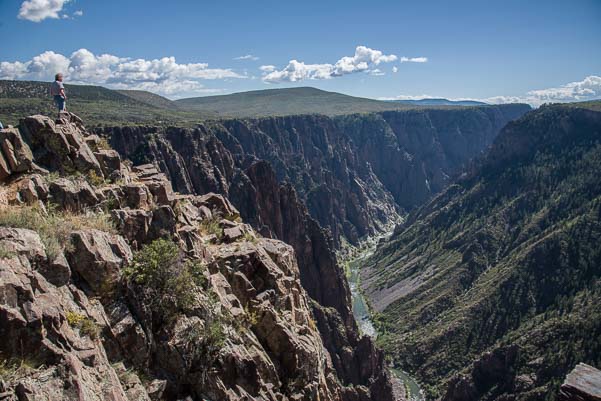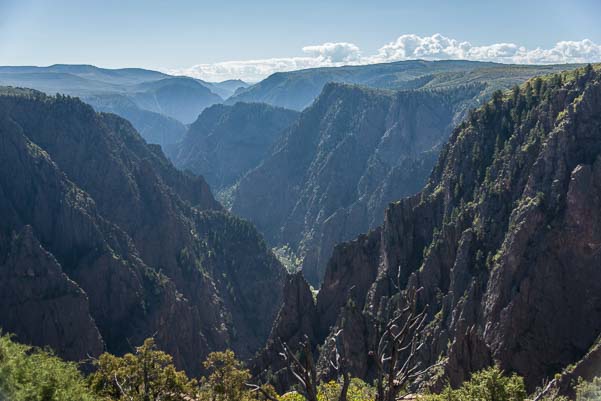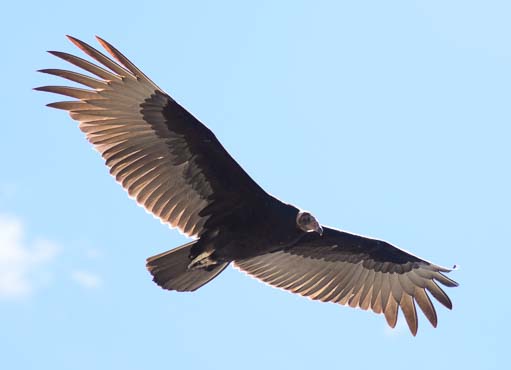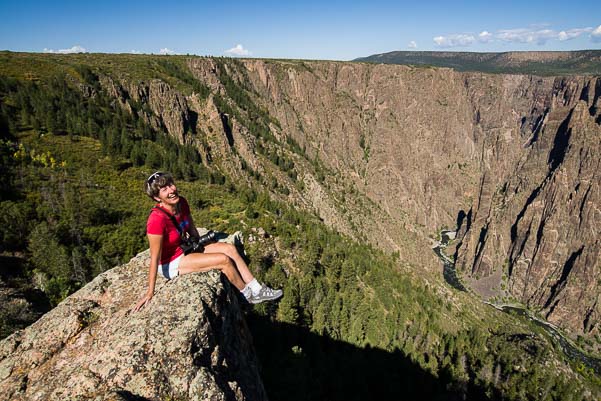
Bicycles on scenic Castle Creek Road
September, 2014 – Maroon Bells may be the most photographed spot in Colorado’s Rocky Mountains, but nearby Castle Creek Road is also very scenic and not nearly as heavily visited.
We drove out one day and passed a steady stream of cyclists enjoying an exhilarating road ride. What a place for a morning workout!
A tiny historic ghost town named Ashcroft lies at the end of the road.
The old buildings were interesting, but we were more intrigued by a row of colorful rugs we saw hanging outside a shop very close by.

The rug weavers of Oaxaca come to Colorado!
Above the shop a sign read: “Welcome to the Catto Center at Toklat.”
We walked past the many rugs, admiring their designs, and then stepped inside.
We were suddenly surrounded by woven wool rugs that looked very similar to the ones we had seen near Oaxaca at Teotitlán de Valle in Mexico a few years ago.
A friendly looking woman was giving a demonstration to several tourists, showing them how the blue dyes were derived from indigo.

Black Canyon of the Gunnison
Our jaws dropped. That was exactly the same demonstration that we had seen in Teotitlán de Valle!
It turned out that this woman came from a family of rug weavers in that very same Mexican village.
I remembered vividly how our tour guide in Oaxaca had squished a bug in the palm of a girl’s hand to demonstrate how they made their red dyes (see my blog post about it here).
Apparently, the owner of this shop’s building had brought a few Oaxacan weavers to Colorado to promote their craft each summer. How fun!

The chasm is vast and deep
Where Maroon Bells and Castle Creek had shown us Colorado’s Rocky Mountains in the early stages of their fall glory, another land of stunning scenery — Black Canyon of the Gunnison — beckoned.
This canyon’s jagged cliffs are nothing like the soaring Rocky mountains.
Instead of craning our necks to look up at tall mountain peaks, the Black Canyon of the Gunnison is like a massive crack in the earth’s surface, with the sides parted to reveal sheer rock walls plunging nearly straight down to a thin ribbon of river far below.

A turkey vulture soars past
The canyon wasn’t formed by the walls cracking apart, however. It was formed by the very fast moving Gunnison River cutting through the rock like knife.
The Gunnison River falls from great heights to great depths, dropping an average of 95 feet per mile. This keeps the water moving at quite a clip.
This raging water has cut through the black rock like a laser, deepening the canyon faster than other kinds of erosion can widen it.

The canyon is steep and deep!
At its narrowest point, it is just ¼ mile across, and the depths of the sheer walls range from 1,750 to 2,700 feet (by comparison, the Empire State Building is 1,454′ feet tall and would reach just partway up the walls!).
As we approached the rim at an overlook, we saw several turkey vultures circling right overhead. They played with the air currents and dove down into the canyon and rose back out again effortlessly.
What a thrill it would be to fly like that, letting the earth fall away from under you as you flew over the rim of the canyon!
The Black Canyon of the Gunnison fills a huge area along the Gunnison River, and there are two wonderful areas for exploring it: a National Park with an entrance on the south rim and a gorgeous scenic drive that snakes along Route 92 on the north rim.

I got a kick out of crawling around on the ledges.
At the Visitors Center for the Black Canyon of the Gunnison National Park we noticed a bulletin board covered with little hand written notes.
“Happy Birthday, Wilderness!” a sign said, recognizing 2014 as the 50th anniversary of the Wilderness Act.
We learned that this 1964 Act set aside 110 million acres of land, created the National Wilderness Preservation System, and gave Congress the ability to designate official “Wilderness Areas.”

The “Painted Wall” is one of the most stunning overlooks.
Beneath the sign was a quote from Edward Abbey, novelist, environmentalist, and critic of public land policies.
“Wilderness is not a luxury but a necessity to the human spirit,” he was quoted as saying.
On this bulletin board, the rangers had posed the question, “What does Wilderness mean to you?” The notes tacked all over the board were full of thought-provoking answers:
“Free & Wild!” penned one person, adding a smiley face for emphasis.

What a great place to explore!
“A place to discover who/what you are made of/for/by” responded another with a little red heart.
“It humbles me…puts me back in place,” someone had written. Next to that another had scrawled, “DITTO.”
I got a kick out of reading these notes.
In hindsight, it is especially interesting to read them now in light of the recent public outcry against restricting commercial filming in officially designated Wilderness Areas.
People treasure wild land.

To get a feeling for the scale of the place, here’s our truck dwarfed by the peaks!
“Wilderness speaks…to my soul,” one card said.
Wildnerness is “one place in the world where man is insignificant and always will be,” another proclaimed.
The Black Canyon of the Gunnison is a National Park with the usual roads and overlooks. However, portions of it are officially designated “Wilderness.”
Yet, back in 1881-82, over 1,000 immigrants from Italy and Ireland worked in horrible conditions full of rock slides, avalanches, and unreliable explosives to push the Rio Grande narrow gauge railroad through this canyon.

At the base of the cliffs of Black Canyon
It is hard to imagine the harsh working environment these men endured, sleeping and eating in wooden work cars and bedding down on wooden planks.

We drove along the Gunnison River at the bottom of the canyon.
Staring down into the canyon from the overlooks that have been carefully designed and built by the National Park Service, it is even harder to imagine the raw triumph these men must have felt when the first train puffed its way through the canyon.
The trains and railroad had defeated the wilderness at last.
This railway was touted as the “Scenic Line of the World,” and the trains carried thousands of people and tons of goods and livestock through the canyon.
“Wilderness is my heaven,” says one of the cards at the Visitors Center.
“What a Creator we have! Praise His name!” says another.

The sun played on the leaves of the trees as they reflected in the water.
Down at the base of the canyon along the Gunnison River, the sun played with the green leaves of the trees and their reflections in the placid water.
Finding that delicate balance between our urge to conquer and make use of our most beautiful landscapes and our urge to protect them and leave them alone has challenged our leaders and thinkers for nearly two centuries.
Mark and I both read the Autobiography of Ansel Adams and were astonished to learn just how hotly the mission of the National Park Service and other public land agencies were debated in the early 1900’s.

Mirror images in the Gunnison River.
We think of Adams as a photographer, but he was deeply involved in the early development of the Sierra Club, and he had very strong opinions about the National Park Service, most of them far from flattering.
He was fortunate to see these lands at their most untouched, and he felt that in many ways he was documenting a disappearing landscape.
Of course, he was not nearly as comfortable in his tent in the early decades of the 1900’s as we are running around in our luxury fifth wheel today. And that is the deepest irony of what “wilderness” really means.

At the river’s edge in the bottom of the canyon.
To make wild landscapes easily accessible requires roads, railways and other development. That gives us laymen a chance to get inside the scenery and enjoy the beauty.
But the very presence of those developments changes the landscape forever.
The “wild” in “wilderness” springs from its very inaccessibility. The more accessible it becomes, the less wild it can be, by definition.
Even though much of the Black Canyon of the Gunnison is officially a Wilderness Area, much of it has also been tamed.

Curecanti National Recreation Area (Blue Mesa Reservoir) is at the east end of the Black Canyon of the Gunnison.
“Earth untouched by man,” is what ‘wilderness’ means to one person who answered the ranger’s query with a card on the wall at the Visitors Center.
Yet that very description is a dream and a fantasy for all but the most intrepid trekkers among us.
That kind of wilderness certainly isn’t a place you can drive by in a heated or air conditioned car, like the beautiful overlooks at the Black Canyon that are the only parts of it most of us will ever reach.
Perhaps the last card summed it up best:
Wilderness means “Hope — even if I never see those places that are truly wild.”
____________________
Although I wouldn’t drive a big RV on scenic Route 92 (where the views of the canyon are truly dramatic), this whole area can be enjoyed using Montrose, Gunnison or the Curecanti National Recreation Area as a home base. Lake Fork Campground is on the water’s edge at Blue Mesa Reservoir and was almost empty when we visited. Check out these links to learn more about:
- Colorado’s Black Canyon of the Gunnison National Park
- The Curecanti National Recreation Area
- The Black Canyon of the Gunnison Wilderness Area
- The nearby Gunnison Gorge Wilderness Area.
More blog posts from our RV trips to Colorado:
- Escape to Paradise – Rocky Mountain Magic!
- Sheep May Safely Graze (in the Mountains with Dogs!)
- Hartman Rocks – A Different View of Colorado near Gunnison
- Creede, CO – Mining History & Championships + 4th of July!
- Buena Vista Colorado – What a Place for an RV Breakdown!
- Rocky Mountain National Park & Trail Ridge Road: RV? Dog??
- Lake Granby Colorado RV Trip – A Summer Beach Vacation!
- Remote RV Camping: Antero Reservoir & Blue River Colorado
- Burro Days! Burro Races, Llamas & Outhouses in Fairplay CO
- Crested Butte – Wildflower Capital of Colorado!
- Silver Thread Scenic Byway in Colorado – Fire in the Sky!
- Telluride Gondola Ride in Colorado – FREE and Dog Friendly!
- Rocky Mountain High: Alpine Beauty in Colorado + Trout Lake!
- Where All News is Good News – At the Saguache Crescent in CO
- Lakes and Light in Wyoming and Colorado
- Colorado’s Stunning Scenic Drives…by Porsche!
- Cowboy Poetry Gatherings in Durango, Colorado, and Alpine, Texas!
- Brilliant Fall Foliage + Snow in the San Juan Mountains of Colorado
- Colorado’s San Juan Skyway – An RV Trip in Dazzling Fall Color!
- San Juan Mountains Colorado – And then it Snowed!
- RV Trip on Colorado’s Million Dollar Highway – Ouray to Silverton
- Ouray – Finding the COLOR in Colorado on an RV Trip!
- Romance at Maroon Bells Colorado!
- Colorado GOLD – A Fall Foliage Photography Workshop
- Ridgway, CO – Peak fall foliage on the Dallas Divide – WOW!!
- Colorado National Monument & Fruita CO – Red Rocks, Cycling & Wine!
- Mesa Verde National Park, CO – Life on the Edge with the Ancients
<-Previous || Next->
